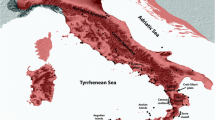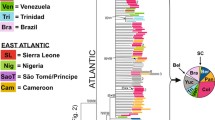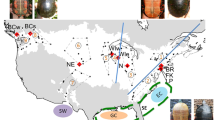Abstract
Human mediated biological invasions are seen as an increasing danger for biodiversity. On the other hand, range expansions are natural processes. It is often practically not possible to tell these processes apart, like in the case of the freshwater crab Potamon fluviatile. This species has a disjunct distribution on the Balkan Peninsula, Italy, Sicily and Malta. An innovative analysis framework involving phylogeographic model selection and temporal coalescent analyses on a mitochondrial dataset (COI and NADH1) could clarify that the origin of the species was on the Balkans and the colonisation of Italy proceeded from the northern Balkans via southern Italy in the Otranto Strait region. The population expansion associated with this invasion was estimated to have taken place 15,000 years before present (95% c.f. 10,000–24,000 years BP). An anthropogenic introduction is therefore implausible and a natural expansion likely. We argue that the species should thus be included in the national conservation management in Italy.






Similar content being viewed by others
Abbreviations
- AIC:
-
Akaike Information Criterion
- AMOVA:
-
Analysis of Molecular Variance
- B.C.:
-
Before Christ
- BP:
-
Before Present
- COI:
-
Cytochrome Oxidase subunit I
- IUCN:
-
International Union for Conservation of Nature
- NADH1:
-
Nicotine Amid dehydrogenase subunit 1
- LGM:
-
Last Glacial Maximum
- MCMC:
-
Monte Carlo Markov Chain
- GTR + I + Γ:
-
General Time Reversible + Proportion Invariant + Gamma
- PI:
-
Parsimony Informative
References
Akaike H (1974) A new look at the statistical model identification. IEEE Trans Automat Contr 19:716–723. doi:10.1109/TAC.1974.1100705
Barbaresi S, Cannicci S, Vannini M, Fratini S (2007) Environmental correlates of two macro-decapods distribution in Central Italy: multi-dimensional ecological knowledge as a tool for conservation of endangered species. Biol Conserv 136:431–441. doi:10.1016/j.biocon.2006.12.013
Beerli P, Felsenstein J (2001) Maximum likelihood estimation of a migration matrix and effective population sizes in n subpopulations by using a coalescent approach. Proc Natl Acad Sci USA 98:4563–4568. doi:10.1073/pnas.081068098
Bettoni E (1884) Prodromi della faunistica bresciana. Apollonio, Brescia
Blackburn TM, Petchey OL, Cassey P, Gaston KJ (2005) Functional diversity of mammalian predators and extinction in island birds. Ecology 86:2916–2923. doi:10.1890/04-1847
Brandis D (1997) Untersuchungen zur Morphologie und Systematik altweltlicher Potamidae (Brachyura, Decapoda, Crustacea). Dissertation, Ruprecht-Karls-Universität Heidelberg
Brandis D, Storch V, Türkay M (2000) Taxonomy and zoogeography of the freshwater crabs of Europe, North Africa, and the Middle East. Senckenb Biol 80:5–56
Broodbank C (2006) The origins and early development of Mediterranean maritime activity. J Mediterr Archaeol 19:199–230. doi:10.1558//jmea.2006.v19i2.199
Brower AVZ (1994) Rapid morphological radiation and convergence among races of the butterfly Heliconius erato inferred from patterns of mitochondrial DNA evolution. Proc Natl Acad Sci USA 91:6491–6495. doi:10.1073/pnas.91.14.6491
Chapman JW, Carlton JT, Bellinger MR, Blakeslee AMH (2007) Premature refutation of a human-mediated marine species introduction: the case history of the marine snail Littorina littorea in the Northwestern Atlantic. Biol Invasions 9:995–1008. doi:10.1007/s10530-007-9098-9
Chapman JW, Blakeslee AMH, Carlton JT, Bellinger MR (2008) Parsimony dictates a human introduction: on the use of genetic and other data to distinguish between the natural and human-mediated invasion of the European snail Littorina littorea in North America. Biol Invasions 10:131–133. doi:10.1007/s10530-007-9115-z
Cerchiai L, Jannelli L, Longo F (2004) The Greek cities of Magna Graecia and Sicily. Getty Trust, Los Angeles
Clement M, Posada D, Crandall KA (2000) TCS: a computer program to estimate gene genealogies. Mol Ecol 9:1657–1660. doi:10.1046/j.1365-294x.2000.01020.x
Cunningham CW (2008) How to use genetic data to distinguish between natural and human-mediated introduction of Littorina littorea to North America. Biol Invasions 10:1–6. doi:10.1007/s10530-007-9099-8
Depraz A, Cordellier M, Hausser J, Pfenninger M (2008) Postglacial recolonisation at a snail’s pace (Trochulus villosus): confronting competing refugia hypotheses using model selection. Mol Ecol 17:2449–2462. doi:10.1111/j.1365-294X.2008.03760.x
Donnelly MJ, Licht MC, Lehmann T (2001) Evidence for recent population expansion in the evolutionary history of the malaria vectors Anopheles arabiensis and Anopheles gambiae. Mol Biol Evol 18:1353–1364
Donoghue PCJ, Benton MJ (2007) Rocks and clocks: calibrating the Tree of Life using fossils and molecules. Trends Ecol Evol 22:424–431. doi:10.1016/j.tree.2007.05.005
Drummond A, Rambaut A (2003) BEAST v1.0. http://evolve.zoo.ox.ac.uk/beast/. Cited 5 March 2008
Drummond AJ, Rambaut A, Shapiro B, Pybus OG (2005) Bayesian coalescent inference of past population dynamics from molecular sequences. Mol Biol Evol 22:1185–1192. doi:10.1093/molbev/msi103
Drummond AJ, Ho SYW, Phillips MJ, Rambaut A (2006) Relaxed phylogenetics and dating with confidence. PLoS Biol 4:699–710. doi:10.1371/journal.pbio.0040088
Duran S, Giribet G, Turon X (2004) Phylogeographical history of the sponge Crambe crambe (Porifera, Poecilosclerida): range expansion and recent invasion of the Macaronesian islands from the Mediterranean Sea. Mol Ecol 13:109–122. doi:10.1046/j.1365-294X.2003.02022.x
Excoffier L, Laval G, Schneider S (2005) Arlequin ver. 3.0: An integrated software package for population genetics data analysis. Evol Bioinform Online 1:47–50
Facon B, Genton BJ, Shykoff J, Jarne P, Estoup A, David P (2006) A general eco-evolutionary framework for understanding bioinvasions. Trends Ecol Evol 21:130–135. doi:10.1016/j.tree.2005.10.012
Fleming K, Johnston P, Zwartz D, Yokoyama Y, Lambeck K, Chappell J (1998) Refining the eustatic sea-level curve since the Last Glacial Maximum using far- and intermediate-field sites. Earth Planet Sci Lett 163:327–342. doi:10.1016/S0012-821X(98)00198-8
Ganong WF (1886) Is Littorina littorea introduced or indigenous? Am Nat 20:931–940. doi:10.1086/274363
Garbini A (1894) Primi materiali per una monografia limnologica del Lago di Garda. Boll Soc Entomol Ital 26:1–94
Gates DM (1993) Climate change and its biological consequences. Sinauer Associates, Sunderland
Gherardi F, Holdich DM (1999) Crayfish in Europe as alien species. How to make the best of a bad situation?. A.A Balkema, Rotterdam
Grammont PC, Cuarón AD (2006) An evaluation of threatened species categorization systems used on the American continent. Conserv Biol 20:14–27. doi:10.1111/j.1523-1739.2006.00352.x
Hall TA (1999) Bioedit: a user-friendly biological Sequence Alignment Editor and Analysis program for Windows 95/98/NT. Nucleic Acid Symp Ser 41:95–98
Hawks J, Hunley K, Lee SH, Wolpoff MH (2000) Bottlenecks and Pleistocene human evolution. Mol Biol Evol 17:2–22
Heads M (2005) Dating nodes on molecular phylogenies: a critique of molecular biogeography. Cladistics 21:62–78. doi:10.1111/j.1096-0031.2005.00078.x
Herbst JWF (1785) Versuch einer Naturgeschichte der Krabben und Krebse. Johann Caspar Fuessly, Zürich 1: 183–206, pl. 10–13
Hewitt GM (1999) Post-glacial re-colonization of European biota. Biol J Linn Soc Lond 68:87–112. doi:10.1111/j.1095-8312.1999.tb01160.x
Hickerson MJ, Gilchrist MA, Takebayashi N (2003) Calibrating a molecular clock from phylogeographic data: moments and likelihood estimators. Evolution 57:2216–2225
Johnson CN, Wroe S (2003) Causes of extinction of vertebrates during the Holocene of mainland Australia: arrival of the dingo, or human impact? Holocene 13:941–948. doi:10.1191/0959683603hl682fa
Johnson JB, Omland KE (2004) Model selection in ecology and evolution. Trends Ecol Evol 19:101–108. doi:10.1016/j.tree.2003.10.013
Kingsley JS (1880) Carcinological notes. Proceedings of the Academy of Natural Sciences of Philadelphia, pp 35–37
Krijgsman W, Hilgen FJ, Raffi I, Sierro FJ, Wilson DS (1999) Chronology, causes and progression of the Messinian salinity crisis. Nature 400:652–655. doi:10.1038/23231
Lee T, Burch JB, Coote T, Fontaine B, Gargominy O, Pearce-Kelly PÒ, Foighil D (2007) Prehistoric inter-archipelago trading of Polynesian tree snails leaves a conservation legacy. Proc R Soc Biol Sci 274:2907–2914
Marshall LG, Webb SD, Sepkoski JJ, Raup DM (1982) Mammalian evolution and the Great American interchange. Science 215:1351–1357. doi:10.1126/science.215.4538.1351
Matisoo-Smith E, Robins JH (2004) Origins and dispersals of Pacific peoples: evidence from mtDNA phylogenies of the Pacific rat. Proc Natl Acad Sci USA 101:9167–9172. doi:10.1073/pnas.0403120101
Perrings C, Dehnen-Schmutz K, Touza J, Williamson M (2005) How to manage biological invasions under globalization. Trends Ecol Evol 20:212–215. doi:10.1016/j.tree.2005.02.011
Pfenninger M, Posada D (2002) Phylogeographic history of the land snail Candidula unifasciata (Poiret 1801) (Helicellinae, Stylommatophora): fragmentation, corridor migration and secondary contact. Evolution 56:1776–1788
Pfenninger M, Schwenk K (2007) Cryptic animal species are homogeneously distributed among taxa and biogeographical regions. BMC Evol Biol 7:121. doi:10.1186/1471-2148-7-121
Pretzmann G (1984) Die Gattung Potamon Savigny in der Sammlung des Museo Civico di Storia Naturale „G. Doria” in Genua. Estratto dagli Annali del Museo Civico di Storia Naturale di Genova 85:119–123
Pretzmann G (1987) A contribution to a historic analysis of Mediterranean freshwater decapods chorology. Investig Pesq 51:17–25
Pretzmann G (1995) Ergebnisse langjähriger Studien an Süßwasserdecapoden. Sitzungsberichte Mathematisch-naturwissenschaftliche Klasse Abteilung I, Österreichische Akademie der Wissenschaften 202:42–53
Ricciardi A, Neves RJ, Rasmussen JB (1998) Impending extinctions of North American freshwater mussels (Unionoida) following the zebra mussel (Dreissena polymorpha) invasion. J Anim Ecol 67:613–619. doi:10.1046/j.1365-2656.1998.00220.x
Ronquist F, Huelsenbeck JP (2003) Mr Bayes 3: Bayesian phylogenetic inference under mixed models. Bioinformatics 19:1572–1574. doi:10.1093/bioinformatics/btg180
Schubart CD, Huber MGJ (2006) Genetic comparisons of German populations of the stone crayfish, Austropotamobius torrentium (Crustacea: Astacidae). Bull Fr Peche Piscicult 380–381:1019–1028. doi:10.1051/kmae:2006008
Schubart CD, Diesel R, Hedges SB (1998) Rapid evolution to terrestrial life in Jamaican crabs. Nature 393:363–365. doi:10.1038/30724
Stephens PA, Buskirk SW, Martinéz del Rio C (2007) Inference in ecology and evolution. Trends Ecol Evol 22:192–197. doi:10.1016/j.tree.2006.12.003
Strayer DL, Eviner VT, Jeschke JM, Pace ML (2007) Understanding the long-term effects of species invasions. Trends Ecol Evol 21:645–651. doi:10.1016/j.tree.2006.07.007
Acknowledgements
Many thanks are due to Silvia Barbaresi and Lapo Ragionieri for their help in the field and in the lab. We also thank Gianna Innocenti, Andrea De Paoli, Alessio Bruni, Lorenzo Gori and Annamaria Nocita. Martin G.J. Huber, Silke Reuschel, Petra Zillner, Reiner Rubner and Hermanfrid Schubart are acknowledged for their assistance in the field, Stefanie Sahner, Susanne Siebeneicher and Melanie Grudinski for their help in the lab. Dirk Brandis and Klaus-Gerhard Heller provided some specimens from the Balkans. We sincerely like to thank Daniele Macale and the National Park staffs of Cilento e Vallo di Diano, Pollino, and Aspromonte for sampling permits. Peter C. Dworschak from the Natural History Museum in Vienna and Michael Türkay from the Senckenberg Museum in Frankfurt/Main made their museum collections available. Marco Vannini supported this research with Fondi Ateneo and a VIGONI project (University of Florence). Christoph Schubart and Ruth Jesse were supported by the DAAD-Vigoni exchange program D/04/47157. Further financial support was provided by the Hermann Willkomm-Foundation (Frankfurt/Main). We are grateful to two anonymous referees for their helpful comments on our manuscript.
Author information
Authors and Affiliations
Corresponding author
Rights and permissions
About this article
Cite this article
Jesse, R., Pfenninger, M., Fratini, S. et al. Disjunct distribution of the Mediterranean freshwater crab Potamon fluviatile—natural expansion or human introduction?. Biol Invasions 11, 2209–2221 (2009). https://doi.org/10.1007/s10530-008-9377-0
Received:
Accepted:
Published:
Issue Date:
DOI: https://doi.org/10.1007/s10530-008-9377-0




